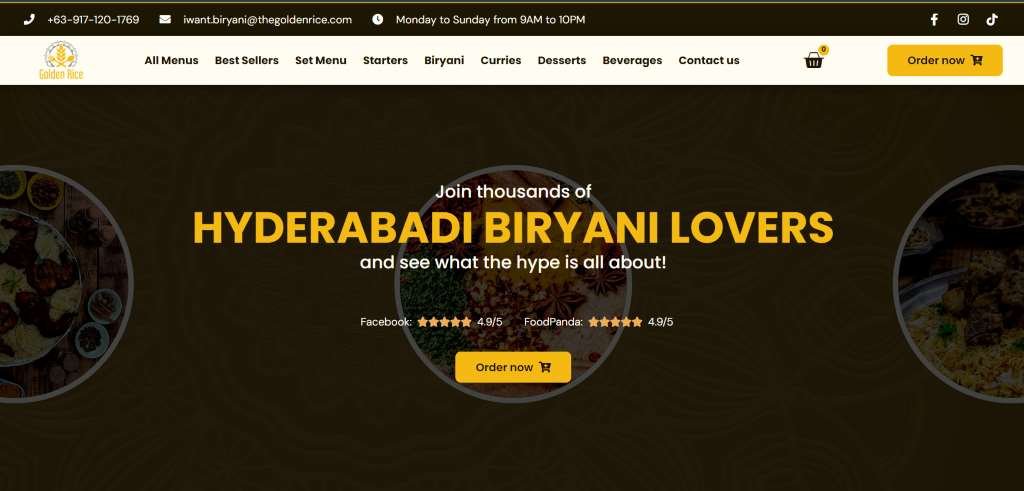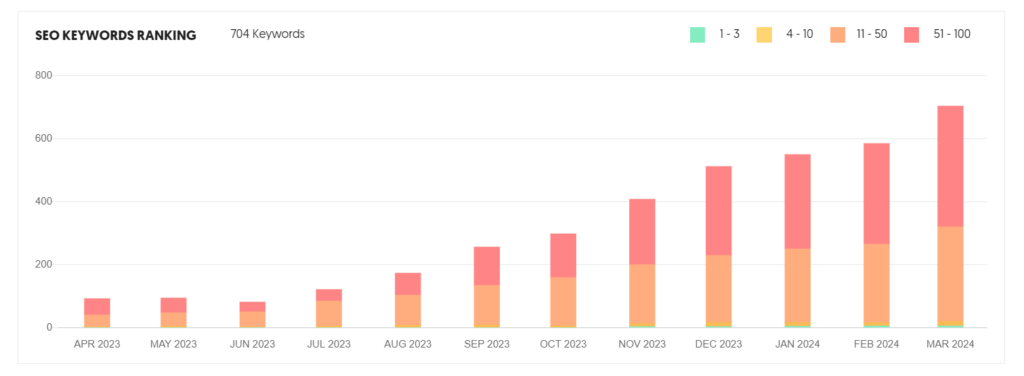RESTAURANT
Case Study: The Golden Rice Hyderabadi Biryani
How a local Indian restaurant owner saved money and made additional source of online revenue with an ecommerce solution?
Overview
The Golden Rice Hyderabadi Biryani is a popular new Indian restaurant in the Philippines. They are renowned for their delicious, authentic Hyderabadi Biryani, Karahi, Masala, and other famous Indian dishes. Their menu is loved by many including famous Filipino celebrities.
Their first website was static and created with WordPress. It displayed information about their restaurant and menu using several 5MB image files. The overall design was disorganized, and there were inconsistencies in user experience (UX) and user interface (UI). However, the most critical aspect that could have benefited their business was absent: the online ordering and payment system.



Challenges
The current Golden Rice Hyderabadi Biryani website, lacking online ordering and featuring a clunky design, hindered customer engagement and limited online sales potential.
The company used a third-party service for ordering and delivery, which cost them extra money that could have been used for expansion.
The website was disorganized and difficult to navigate, violating good UX/UI best practices.
The website did not have any ordering or payment capabilities.
The website lacked sufficient information to help new customers understand their dishes.
The website was mostly ranking for brand keywords, which limited their online presence.
Objectives
- The primary objective of the project was to redesign the website and adding online ordering and payment system.
- To expand to non-brand keywords.
- To optimize the website performance.
- To add more helpful content or information to help customers learn about their products.

Solution
Golden Rice Hyderabadi Biryani’s website needed a makeover. I revamped it with a user-friendly design, online ordering with payment gateway, and informative content to educate customers.
- Website redesign
- Performance improvements
- Technical SEO
- On-page optimization
- Keyword research
- WooCommerce integration
- Local payment gateway integration (Paymongo)
- Local delivery service integration
1. Website redesign to improve the user experience and the user interface (UX/UI)
I used WordPress and Elementor Builder to develop a user-friendly interface and content management system. I do not use pre-built templates that anyone can buy on template marketplaces.
Using a sketchbook, I create sketches of how I want every major page to look. From the homepage to a single service page, and even the contact page, everything is customized.
Next, I created and tested a functional prototype which I presented to the client for initial feedback.
2. Improved the Site Performance
Site performance is an important factor in web design and search engine optimization.
To improve website performance, I streamlined the website’s foundation by removing inactive and redundant WordPress plugins, and optimized all images to be under 100kb. I also leveraged the hosting provider’s built-in optimization plugins that were previously unused.
3. Fix Technical SEO issues
A WordPress website, even the newly built ones, are sure to encounter technical SEO issues. This is, in my experience, a common occurrence because it is difficult to monitor every aspect during the development stage. An audit must be done before deployment.
So, using Screaming Frog, I audited the website to fix issues early on before deploying. This ensures that there will be no complications in SEO.
4. On-Page SEO Optimization
Though I was not commissioned to SEO the site, I made sure that it is SEO-friendly. After addressing the website’s technical SEO issues, I focused on optimizing individual pages, particularly the homepage and service pages. Utilizing Screaming Frog, I identified on-page SEO problems that could hinder search engine ranking.
5. WooCommerce and Local Payment Integration
As a restaurant business, we could take advantage of the WooCommerce platform to develop an online ordering system along with a local payment gateway called PayMongo.
The system helped the owner reduce their reliance on third-party ordering platforms such as Foodpanda, GrabFood, and Beep.
6. Local Delivery Service Integration
An online ordering system is not complete without a delivery service integrated into it.
So, to streamline the process, I also integrated a local delivery service called Lalamove into the system. This helped the store manager to book a delivery rider within WordPress quickly and easily.
Results
Money Saved from Paying 3rd-Party Services
Additional Chanel for Sales
Better User Experience with an Ecommerce Solution
700+ Organic Keywords Gained
183% Increase in Monthly Organic Traffic
Increase Online Brand Awareness
1. Extra money saved from paying 3rd-party online and delivery services.
The development of the ordering and payment system using WordPress and WooCommerce enabled the owner to unsubscribe from a third-party service.
They can now accept orders through their website without having to pay for other services, saving them money.
3. Improved ordering experience with ecommerce system.
The conversion of the website into an e-commerce platform using WordPress, WooCommerce, and PayMongo enabled users to place orders directly from the website fast and easily.
As for the owners, they can book delivery riders within the system, improving operations and saving time.










